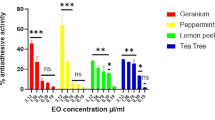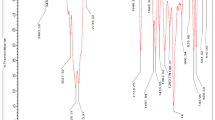Abstract
Medicinal plants with antimicrobial action have been investigated for uses against biofilms, among which, Cymbopogon nardus, citronella, stands out as a promising species. The present study aims to evaluate the antimicrobial and antibiofilm action of the essential oil of C. nardus (EOCN) and geraniol on Gram-negative and positive bacteria from the determination of minimum inhibitory concentration (MIC) and minimum bactericidal concentration and inhibition of biofilms. In the results, the EOCN produced a 41 mm halo on S. aureus, which was susceptible with MIC values of 0.5 and 0.25 mg/mL for the EOCN and geraniol respectively, both with bactericidal effect. The antibiofilm action was confirmed, the EOCN and geraniol reduced the biofilm biomass of S. aureus up to 100% between 0.5 and 4 mg/mL concentrations. The reduction of cell viability was 0.25 and 1 mg/mL, of EOCN and geraniol, respectively. EOCN and geraniol were shown to be promising antibiotic against S. aureus.

Similar content being viewed by others
References
Agnolin CA, Olivo CJ, Leal MLR, Meinerz GR, Parra CLC, Machado PR, Foletto V, Bem CM, Nicolodi PRSJ. Efficacy of citronella oil Cymbopogon nardus (L.) Rendle in the control of bovine ectoparasites. Rev Bras Pl Med. 12: 482–487 (2010)
Aguiar RWS, Ootani MA, Ascencio SD, Ferreira TPS, Santos MM, Santos GR. Fumigant antifungal activity of Corymbia citriodora and Cymbopogon nardus essential oils and citronellal against three fungal species. Sci World J. 492138: 1–8 (2014)
Andrade MA, Cardoso MG, Batista LR, Mallet ACT, Machado SMF. Essential oils of Cymbopogon nardus, Cinnamomum zeylanicum and Zingiber officinale: composition, antioxidant and antibacterial activities. Rev Cienc Agron. 43: 399–408 (2012)
Baptista MGFM. Mechanisms of resistance and selection of antibiotics. Masters dissertation. Universidade Lusófona de Humanidades e Tecnologia, Lisboa, Portugal (2013)
Barreto NSE, Moura FCM, Teixeira JA, Assim DA, Miranda PC. Evaluation of hygienic-sanitary conditions of fish commercialized in the municipality of Cruz das Almas, Bahia. Rev Caatinga. 25: 86–95 (2012)
Bersan SMF, Galvão LCC, Goes VFF, Sartoratto A, Figueira GM, Rehder VLG, Alencar SM, Duarte RMT, Rosalen PL, Duarte MCT. Action of essential oils from Brazilian native and exotic medicinal species on oral biofilms. J Evid Based Complementary Altern Med. 14: 451–463 (2014)
Bordi C, Bentzmann S. Hacking into bacterial biofilms: a new therapeutic challenge. Ann Intensive Care. 1: 1–8 (2011)
Carvalho KIM. Effect of geraniol on experimental peptic ulcer disease. Masters dissertation. Institute of Biosciences of Botucatu, São Paulo, Brasil (2012)
Chaieb K, Kouidhi B, Jrah H, Mahdouani K, Bakhrouf A. Antibacterial activity of thymoquinone, active principle of nigella sativa and its potency to prevent bacterial biofilm formation. BMC Complement Altern Med. 11: 11–29 (2011)
CLSI Clinical and Laboratory Standards Institute. Performance standards for antimicrobial susceptibility testing; Fifteenth Informational Supplement. Document M100-S15 (ISBN 1- 56238-556-9). Pennsylvania, USA (2015)
Coutinho HDM, Freitas MA, Gondim CNF Leite, Albuquerque RS, Ferreira JVA, Andrade JC. In vitro antimicrobial activity of geraniol and caryophyllene on Staphylococcus aureus. Rev Cubana Plant Med. 20: 98–105 (2015)
Di Conza JA, Badaracco A, Ayala J, Rodríguez C, Famiglietti A, Gutkind GO. β-lactamases produced by amoxicillin clavulanate resistant enterobacteria isolated in Buenos Aires, Argentina: a new blatem gene. Rev Argent Microbiol. 46: 210–217 (2014)
Fratamico PM, Bhunia A, Smith JL. Foodborne pathogens: microbiology and molecular biology. Emerg Infect Dis. 12: 453–454 (2005)
Freeman JT, Nimmo J, Gregory E, Tiong A, Almeida M, McAuliffe GN, Roberts AS. Predictors of hospital surface contamination with extended-spectrum β-lactamase-producing Escherichia coli and Klebsiella pneumoniae: patient and organism factors. Antimicrob Resist In. 3: 1–7 (2014)
Guimarães CC, Ferreira TC, Oliveira RCF, Simioni PU, Ugrinovich LA. In vitro antimicrobial activity of aqueous extract and essential oil of rosemary (Rosmarinus officinalis L.) and clove (Caryophyllus aromaticus L.) against strains of Staphylococcus aureus and Escherichia coli. Rev Bras Biocienc. 15: 83–89 (2017)
Havelaar AH, Kirk MD, Torgerson PR, Gibb HJ, Hald T, Lake JR, Praet N, Bellinger DC, Silva NR, Gargouri N, Speybroeck N, Cawthorne A, Mathers C. Organization global estimates and regional comparisons of the burden of foodborne disease in 2010. Plos Med. 12: 1–23 (2015)
Hazwan HM, Man HC, Abidin ZZ, Jamaludin H. Comparison of Citronella oil extraction methods from Cymbopogon nardus grass by ohmic-heated hydro-distillation, hydro-distillation, and steam distillation. Bioresources. 9: 256–272 (2014)
Henrique HC, Freitas MA, Gondim CNFL, Albuquerque RS, Ferreira JVA, Andrade JC. In vitro antimicrobial activity of geraniol and caryophyllene on Staphylococcus aureus. Rev Cubana Plant Med. 20: 98–105 (2015)
Hoffmann S, Devleesschauwer B, Aspinall W, Cooke R, Corrigan T, Havelaar A, Angulo F, Gibb H, Kirk M, Speybroeck RLN, Torgerson P, Hald T. Attribution of global foodborne disease to specific foods: findings from a World Health Organization structured expert elicitation. Plos One. 14: 1–26 (2017)
Millezi AF, Baptista NN, Caixeta DS, Rossoni DF, Cardoso MG, Piccoli RH. Chemical characterization and antibacterial activity of essential oils of condiment and medicinal plants against Staphylococcus aureus and Escherichia coli. Rev Bras Pl Med. 16: 18–24 (2014)
NIST. National Institute of Standards and Technology. 2,6- Octadienal, 3,7-dimethyl. Disponível: http://webbook.nist.gov/cgi/cbook.cgi?ID=C5392405&Mask=200. Accessed on: 03/03/2016
Oliveira MMM, Brugnera DF, Cardoso MG, Alves E, Piccoli RH. Disinfectant action of Cymbopogon sp. essential oils in different phases of biofilm formation by Listeria monocytogenes on stainless steel surface. Food Control. 21: 549–553 (2010)
Oliveira MMM, Brugnera DF, Cardoso MG, Guimarães LGL, Piccoli RH. Yield, chemical composition and antilisterial activity of essential oils of Cymbopogon species. Rev Bras Pl Med. 13: 8–16 (2011)
Portal Saúde. Outbreaks of Foodborne Diseases in Brazil. Available in: http://portalsaude.gov.br. Accessed on: September 28, 2016
Sá CSN, Cavalcante TT, Araújo AX, Santos HS, Albuquerque MR, Bandeira PN, Cunha RM, Cavada BS, Teixeira EH. Antimicrobial and antibiofilm action of casbane diterpene from Croton nepetaefolius against oral bacteria. Arch Oral Biol. 5: 550–555 (2012)
Silveira SM, Júnior AC, Scheuermann GN, SecchiI FL, Verruk S, Krohn M, VieiraI CRW. Chemical composition and antibacterial activity of the essential oils of Cymbopogon winterianus (citronella), Eucalyptus paniculata (eucalypt) and Lavandula angustifolia (lavender). Rev Inst Adolfo Lutz. 71: 471–480 (2012)
Simões CMO, Schenkel EP, Gosmann G, Mello JCP, Mentz LA, Petrovick PR. Pharmacognosy of the plant to the drug. 6 ed. UFRGS, Florianópolis (2010)
Tong F, Gross AD, Dolan MC, Joel R. The phenolic monoterpenoid carvacrol inhibits the binding of nicotine to the housefly nicotinic acetylcholine receptor. Pest Manag Sci. 69: 775–780 (2013)
Trombetta D, Castelli F, Sarpietro MG, Venuti V, Cristani M, Daniele C, Mazzanti SAG, Bisignano G. Mechanisms of antibacterial action of three monoterpenes. Antimicrob Agents Ch. 49: 2474–2478 (2005)
Van Den Dol H, Kratz PD. A generalization of the retention index system incluinding linear temperature programmed gas liquid partition chromatography. J Chromatogr. 11: 463–471 (1963)
Acknowledgements
We would like to thank the Coordination of Improvement of Higher Education Personnel -CAPES for financial support.
Author information
Authors and Affiliations
Corresponding author
Rights and permissions
About this article
Cite this article
Pontes, E.K.U., Melo, H.M., Nogueira, J.W.A. et al. Antibiofilm activity of the essential oil of citronella (Cymbopogon nardus) and its major component, geraniol, on the bacterial biofilms of Staphylococcus aureus. Food Sci Biotechnol 28, 633–639 (2019). https://doi.org/10.1007/s10068-018-0502-2
Received:
Revised:
Accepted:
Published:
Issue Date:
DOI: https://doi.org/10.1007/s10068-018-0502-2




